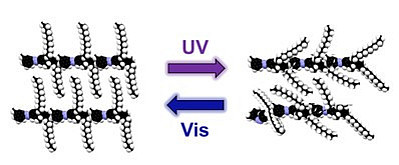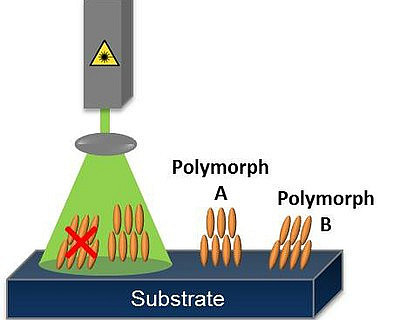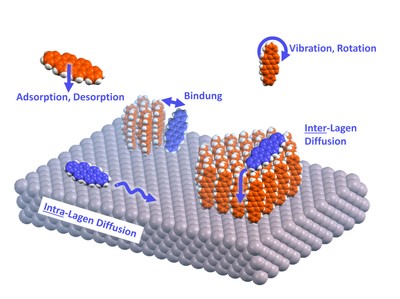Forschung
Unsere Forschung beschäftigt sich mit.....
Molecular switching processes and photoresponsive materials
Molecular switches are molecules that can be switched reversibly between at least two different stable states (isomers). Thus photoresponsive materials that consist of molecular switches permit a controlled manipulation of structural and functional properties such as geometric structure, optical absorption, dipole-moment, conductance etc. by the use of external stimuli (e.g. light, temperature, currents, mechanical forces). Possible applications range from molecular electronics and optomechanics to energy and information storage. Using X-ray scattering and optical spectroscopy we study the geometrical and electronic changes and focus on the interaction between switches in the solid state to achieve cooperative switching (‘domino effect’). This results in the amplification of a trigger event, which is useful e.g. for controlled energy release or in sensing applications.


https://doi.org/10.1021/cg501734w
Light as control parameter in crystallisation
Control of crystallization in organic thin films is one of the challenges of todays' organic semiconducting devices and molecular materials in general. Commonly the parameter space in Organic Molecular Beam Deposition (OMBD) consists of substrate temperature and molecular deposition rate. We investigate the influence of light on thin film growth processes. We focus on real time x-ray diffraction experiments and also study the fundamental interactions leading to light controlled organic crystal growth. In a recent study we have shown that the crystalline quality of sexithiophene thin films can be enhanced through illumination.
Hybrids of inorganic and organic semiconductors
Hybrids of inorganic and organic semiconductors can combine the advantages (and avoid the disadvanteges) of molecular and inorganic semiconductors. The morphology, crystal-phase purity and molecular orientation at hybrid organic-inorganic semiconductor interfaces have a crucial impact on the performance of hybrid optoelectronic devices. Therefore mechanisms to control growth processes are needed for a rational interface design. By a defined, slight chemical modification of well-known model molecules like para-sexiphenyl (6P) it is possible to strongly influence the molecular self-assembly without changing the functional properties of the molecule. We perform real time and in situ X-ray diffraction as well as AFM measurements and modelling to investigate the changes of the growth-mode, the molecular diffusivity and the interlayer mass transport due to the incorporation of functional groups, that introduce for example a dipole moment and influences the intermolecular interactions.
Real-time observation of growth processes
Growth is by definition a non-equilibrium process and therefore the final structure is not only determined by energetic arguments but also the route on which a functional nanomaterial has been manufactured. Therefore it is of great importance to measure not only the final, static, structure, but to observe the growth kinetics including transient structures and changes in growth mode after critical thicknesses. We combine X-ray growth oscillations, that is strong oscillations in the X-ray intensity specularly reflected from the sample, with the weak, time resolved diffuse scattering (GISAXS) signal during growth. Using this novel combination and kinetic Monte Carlo simulations we can determine the speed with which the fundamental processes of diffusion, nucleation, and hopping across step edges occur. This makes it possible to simulate growth processes and predict functional nanostructures.
